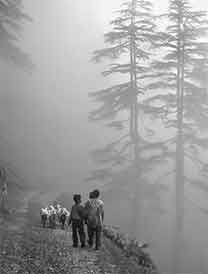

Photographing in the high mountains is not an easy task. What care must one take during such expeditions?
Certainly photographing in the Himalayas entails much effort and hardships. But if you love what you are doing, these things will not obstruct your journey. The happiness you get after taking a good picture makes you forget the pain you faced in taking it. They say – who needs a holiday when you love your work? It is indeed true. I have always cherished the satisfaction and joy and never brooded over the difficult and dangerous climbs and treks. All that is taken care of by capturing rewarding shots. I have recently returned from Pangi Valley. My journey to this beautiful place was perilous and the long hours of driving to reach the destination were back-breaking. But as a bonus I was pleased to see the satisfying pictures I had captured. In the end, that is what matters the most.


What are your views about postprocessing of images? What according to you is the right approach towards turning a photograph into an image?
Film technology, to my mind, was a stone-age of photography! You could do nothing after processing the slides. One scratch and the slide is gone! Slight mistake in processing and your whole trip is a write off. Not anymore! Now we can do wonders in post processing. But we should also know where to draw a line; I have a word for it – ‘Lakshman Rekha’. Processing should be done to an extent, it shouldn’t make your image look artificial. Restore to what you saw at the scene. Slight saturation, sharpness, slight change in composition; very moderate touch up is tolerable and desirable. When you go overboard the image looks overdone and unnatural. I also believe that a sound knowledge of Photoshop is a must for photographers since no camera will deliver an image which can be used right away. You have made your mark in the Indian as well as international imaging industry.
You have published 23 books about photography, and two more are in the making. What is it that inspires you to be ceaseless in your pursuit of making a better picture each time?
I believe, life is a ladder and as life progresses, one attempts to climb upward ceaselessly. The first step up the ladder for me was to be able to take technically perfect images. I spent years in B&W and colour darkrooms to learn this technical part. The second step was to get some recognition for my efforts. I successfully did that too and got my photographs published. The third step up the ladder was to pen down my experiences. After ample research and four and a half years of trekking and treading the Garhwal Himalayas, I published my first book. Thus, one book led to another, and my 25th book So Said The Wise will soon be published. The reason I choose to publish my work in the form of books over magazines is because the former has a bigger shelf-life as compared to the latter. They sit in a library or on a bookshelf for many years.

Would you like to share a word of advice for budding photographers and nature lovers?
I will share with the youngsters, an advice, which my beloved father once gave me. He used to say, “Self-criticism is the key; judge your work harshly, see what could have improved and if something is good, try to repeat it next time too. Study the work of masters, try to understand what makes their pictures great. Apply the same tactics in your work. No photograph can be repeated and you cannot imitate the masters, but you can use their work as inspiration”. To a large extent, I have tried to follow his footsteps and achieved a lot from his advice. I absolutely believe that the key to achieving your goals is experimentation. I am proud to say that I began moonlight photography in this country way back in 1983, using large format cameras with exposures going from one to four hours. These are the experiments and the risks that I took which paid me rich dividends. Do not expect to become the masters of your art in a short time. Remember, first 75 years of a photographer are tough, then it gets easier. Lastly, avoid beating your own drum, avoid packaging and marketing, as no self respecting photographer should indulge in such mediocrity. |SP

